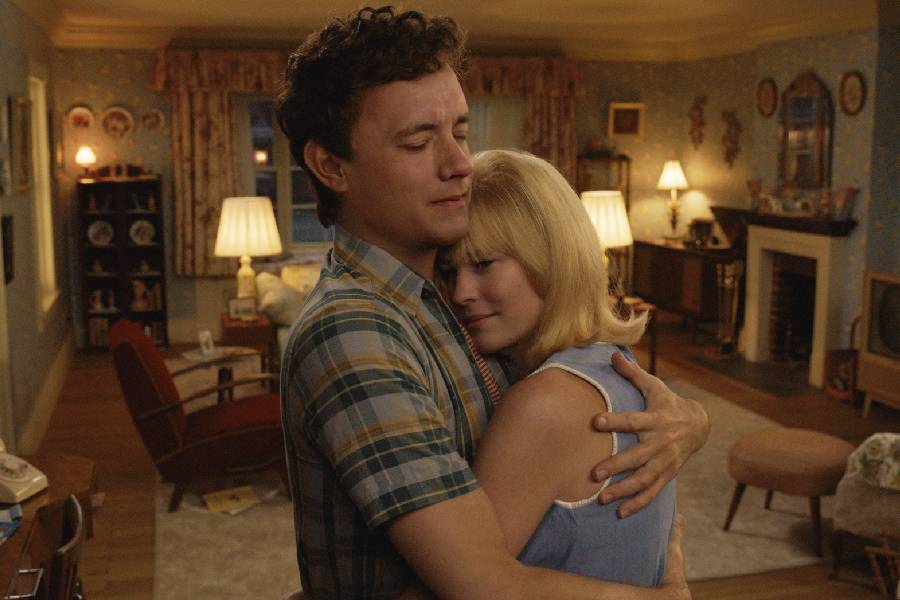2.0 out of 5.0 stars
“Here” was released by SONY Pictures on Nov. 1 to resounding indifference. This film marks the return of Robert Zemeckis, director of “Forrest Gump” and “Back to the Future.” It also serves as the long-awaited on-screen reunion of Tom Hanks and Robin Wright.
“Here” had all the makings to be great, yet fails in all the places that count. The film’s concept is simple. The camera never moves. This concept, while interesting, proved difficult in execution for a feature-length film. Despite this, the film has its merits and utilizes its premise to the fullest –– albeit quite dragged out –– potential.
The plot of this movie is convoluted. It jumps around between different time periods, all taking place in the same spot at random points, leaving this concept to come across as a little absurd and disingenuous despite being cool in theory.
The main storyline, which focuses on three generations of the Young family as they change throughout time, is most explored. The first 20 minutes follows Al Young (Paul Bettany) and Rose Young (Kelly Reilly) as they move into their new house and start a family. The focus then transitions to their son Richard, played by Hanks, as he navigates life and grows old with his pregnant girlfriend-turned-wife Margaret Young, who is played by Wright. These characters mainly live out their lives in small snippets throughout the plot, which ultimately results in many of the film’s fumbles.
The main problem is how seriously this film takes itself. It feels like it so desperately wants to bask in its “nuance” and “brilliance,” while at the same time half-baking all of its fairly straightforward concepts. The film opens with a montage of the Jurassic period ending, transitioning into the house that the majority of the film takes place in being built and seeing all the families who moved into it throughout the years. The other families that at one point in time occupied the house are briefly shown throughout the film, but never get too much in terms of importance or screen time. The only other subplot that got attention was about the inventor of the La-Z-Boy. The snippets of his life when he and his wife were living in the house were fun, but ultimately served no purpose.
These snippets are almost always cut short before true emotion can be explored due to the strange pacing the film insists on following. The main storyline is broken up by random subplots which range from interesting –– like the very short, but sweet story of two indigenous people meeting and growing old –– to just plain odd, like when the son of Benjamin Franklin occasionally pops in. The movie becomes less genuine with each unexplored plot point.
The acting in this film leaves something to be desired. The ambitious time jumps do not allow Hanks and Wright breathing room to act, and they leave the characters’ goals and motivations surface-level and undercooked.
On paper, this premise is beautiful; following a family as they grow together, collapse and come back stronger all while time continues to take away opportunities from them, is brilliant. The sacrifice of a man’s dreams to be an artist, the repeating of his father’s mistakes, the ways love can both lift you up and chain you down and the memories of the little things that kept you going — are inherently emotional and profoundly human, yet due to the film’s refusal to give true resolution and breathing room, nothing hits.
Despite its lackluster and half-baked plot, visually, this film was very unique. The idea of a movie where the camera angle doesn’t change is really interesting, and the creative set design really shines when jumping between holidays, seasons, decades and centuries. The film uses a transitional editing style where little white squares compile the screen to slowly transition from one scene to the next, providing glimpses into various other points in time. The living room could be flooded with light from a sunny day, and then a white box would appear in the corner showing some Halloween decorations. Then another appears in front of the window, showing the cool blue night outside, and then suddenly the whole screen transitions into that scene. This never got old. The set design was pretty spectacular, and the living room felt extremely lived in to the point where it felt like a character in and of itself. There was always something new to look at, which is definitely surprising considering this movie is almost two hours long.
The visuals aren’t perfect, however. The CGI is bad — distractingly bad. Seeing the dinosaurs, a very poorly done hummingbird and a de-aged Hanks were all extremely jarring and completely detracted from the audience’s immersion.
Overall, this movie reeks of missed potential. While it isn’t all bad, it certainly leaves much to be desired and should have been heavily tweaked before release. It’s unfortunate to say, but “Here” makes it hard to find where the heart is within this very disappointing home.




















